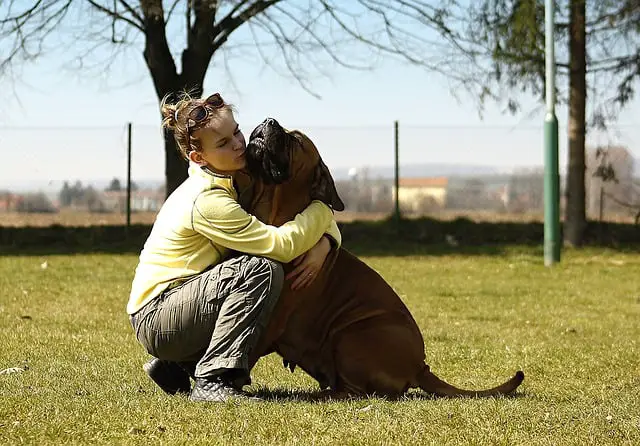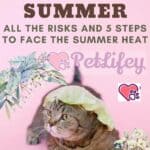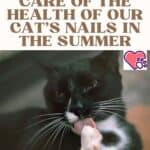
Dogs and cats suffer the ravages of heat more than you. They cannot sweat to cool themselves , since they lack the sweat glands that people do have throughout the body. In part, they perspire through their pads, but above all they expel heat through their mouth; that is why it is sometimes said that these animals sweat through their tongues. But there are ways to help them, like the ones we discuss in this article .
Between 36% and 50% of pets that experience a sudden rise in body temperature die
Cat and dog cooling is not only more complex than human cooling, but also less efficient. This explains why you should never leave your animal alone in the car, not even to run a quick errand. A hot day in which the thermometer reads 32 ºC, inside the car it will not take long to shoot up to 70 ºC – it is a matter of 10 minutes-. And when the mercury rises, the danger of heat stroke is no joke: 36% to 50% of pets that experience a sudden rise in body temperature die. “Heat stroke occurs when the animal’s body collapses due to an excessive increase in temperature. The animal cannot breathe normally, so its ability to cool itself decreases and its vital organs are in danger. In the worst of the cases cases, it can die”.
If you want to help your furry friend have a safe, healthier and refreshing summer, these tips can help .
Water … and even chicken cubes!
The body of dogs and cats works as a high precision thermometer, which is capable of detecting excess heat and pumping it to the tongue to eliminate it. This furry refrigerator expels the temperature through the salivary glands in the form of moisture. For this reason, fresh water is your best ally in summer.
The advice is to place bowls of fresh water in different parts of the house and change it several times a day, so that it is always fresh and appetizing. One trick to make the water desirable for your friend is to add some ice cubes, even frozen chicken broth , cooked without onion or garlic, as these foods are dangerous.
The pet market also makes it easy. Opt for a freezable bowl. These containers are stored in the freezer and when refilled, they keep the water fresh for hours.
Safe and cool rides
To keep the dog hydrated and cool during the walk, choose the less hot hours of the day (before 11:00 a.m. and after 8:00 p.m., after sunset) and opt for leafy paths with plenty of shadows and water sources. Don’t forget to bring a collapsible bowl with you. These gadgets take up little space in your purse and are great for filling with water for more convenient drinking.
Cats and dogs must always be able to take shelter from the heat. Exposures to the sun at rush hour involve several dangers, as there is a risk of collapse. In addition, exercise and games with excessive physical activity must be avoided during the hours of maximum temperatures. And when they are hot, a trick that works – aside from leaving them a cool place at home in the shade – is to get their paws wet. The sweat glands of dogs and cats are concentrated in their pads, so wetting them frequently will help them stay cool.
Croquettes in this heat?
Ice creams are a surprising and very tasty way to refresh your pet: let the dog taste the banana or whisk ice cream and freeze your pussy’s favorite can
You would not dare to eat a good handful of dry croquettes at 3:00 p.m. in the heat of the heat wave. Well, neither does your pet. Dogs and cats have less desire to eat in summer and, in addition, they need some changes in their diet to make it more refreshing.
In the heat it is even more important to distribute the food into three or five servings a day – better five, especially in the case of cats – and make them coincide with the coolest hours of the day. One idea to get organized is to offer breakfast first thing in the morning, a light lunch at noon and a proper dinner in the late afternoon.
And since dogs and cats do not live only on balls, if you combine them with wet cans, fresh food such as yogurt, hydrating vegetables such as pumpkin and fruits such as bananas, apples (without seeds) and blueberries, better than better.
Fruit ice creams!
Ice creams are a surprising and very tasty way to refresh your friend and get them to drink the water it needs.
The ingredients to make a banana ice cream for dogs are the following: a ripe banana, a yogurt and the volume of half water yogurt – better if it is skimmed. The recipe is suitable for beginning cooks of all types: whisk the ingredients until pureed, pour them into an ice cream bucket or mold and wait for them to freeze. Of course, remember to wet the ice cream before offering it to the furry diner so that they do not hurt their tongue.
Felines that are less fussy or accustomed from their puppy stage to other foods will also enjoy the banana snack. But for those who resist, there’s an even more fool proof cat ice cream recipe : shake your favourite can of wet food, add a little water if you like, and pour it all into an ice cream mould your size.
Do you have to cut your hair in summer?
Every summer the same question arises: should we cut the hair of dogs and cats? And how much? Before reaching for the scissors or making an appointment with your pet groomer, remember that hair works like a natural cooler, a hairy tangle that creates drafts and pockets of air that protect you from heat. The vets do not recommend rapper animals in summer, with exceptions like having long hair and prone to tangles.
In the rest of the cases, it is better to opt for a small cut and arm yourself with a good brush. The daily brushing is especially important in hot weather: removes dead hairs that block the expulsion of heat through the body. This gesture, repeated every day, helps you stay cooler.
Which breeds suffer the most from the heat?
Flat animals – such as Persian cats and bulldog, boxer or pug dogs (also called brachycephalic ) – are even more vulnerable to rising temperatures. Its peculiar facial anatomy, which is usually accompanied by folds on the face, prevents the normal flow of air. And the bone of the muzzle is also shortened and narrow. Consequently, the air has less space to access the lungs and the animal breathes worse, which makes it more vulnerable to heat stroke.
Other breeds are less adapted to heat due to their origin and physical characteristics, since their thick fur is more prepared for the cold, this is the case called Nordic breeds, such as Samoyed, Akita, Alaskan Malamute or Siberian Husky and Chow Chow.
And, on the contrary, the breeds that tolerate heat better are those with a long snout, which allows them to breathe – and cool – better. Among them, there is the Doberman, the Pointer, the Pinscher or the Greyhound. But even for them, protecting themselves in the summer is important.






